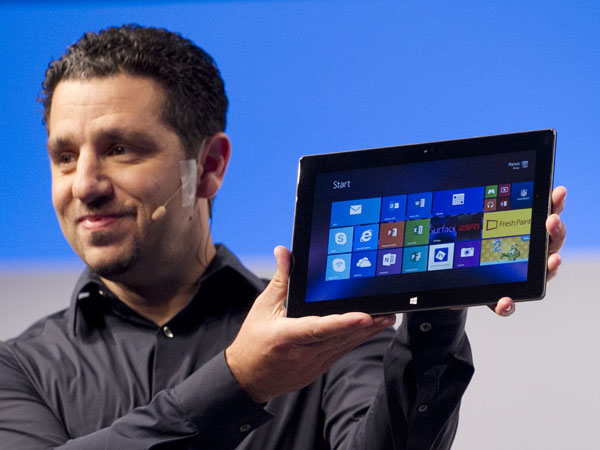
Panos Panay, corporate vice president of Microsoft, introduces a new Surface tablet, Monday, Sept. 23, 2013, in New York. Microsoft is introducing new Surface tablet computers and accessories, including a professional model that allows people to use it more like a laptop or a desktop. AP
NEW YORK—Microsoft unveiled two new versions of its Surface tablet on Monday, renewing its efforts in mobile computing after the product’s launch a year ago failed to impress consumers.
The Surface 2 and Surface 2 Pro have “significant updates, including improvements to processing power and battery life,” Microsoft said at a New York launch event.
The changes represent “the revamp we need,” vice president Panos Panay said, as he presented the new tablets to reporters.
The launch is Microsoft’s second stab at gaining ground in the growing tablet market.
The Surface, released last year, failed to make a dent in a market dominated by Apple’s iPad and various devices using the Google Android operating system.
Microsoft markets the device, which comes with a kickstand and optional keyboard, as a substitute for a tablet with much of the functionality of a personal laptop computer.
Yet the device failed to get more than a two percent share of the global tablet market, according to analysts.
Panay said the new device includes Microsoft’s revamped Windows 8.1 system, the popular Outlook program and access to 10 times as many apps as the previous version.
For US customers, the Surface 2 will start at $449 and the Surface Pro 2 at $899.
It will be sold initially in 22 markets, with pre-orders starting Tuesday and sales to be launched Oct. 22.
Surface 2 Pro, aimed at business users, “is the most productive, powerful tablet in the world,” Panay said at the launch in Manhattan.
“The point of this product is to work fast. The need of the product is to work all the time.”
Panay said Microsoft added about 50 percent more color accuracy, and improved sound with Dolby speakers for the Surface 2 Pro.
It will have the full Microsoft Office suite and will be powered by a fourth-generation Intel “Haswell” processor that boosts both performance and battery life, the company said.
Surface 2
Panay said the basic version, Surface 2 is “a very, very powerful opportunity for people.”
It uses an Nvidia Tegra 4 processor, which Microsoft said runs more quickly and smoothly than its earlier tablet and increases battery life to up to 10 hours for video playback.
Surface 2 is “slightly thinner and lighter than its predecessor,” according to Microsoft, with an upgraded camera for high-definition video.
Early reactions were cautious, with some analysts saying Microsoft has failed to make the device compelling, with only a small price cut for the basic Surface tablet.
“Surface 2 at $449 is better than $499, but not aggressive enough to get people to buy an unproven platform. Plus, (the) keyboard is still extra,” said a tweet from IDC analyst Tom Mainelli.
Mainelli added in another tweet: “Surface Pro 2 is dramatically better than v1. And more storage is key. But pricing is still too high.”
Mike Silver, a Gartner analyst, said the new product had some impressive-looking features, such as an improved keyboard.
But Silver said there are still questions about whether the vast increase in applications represents quantity over quality.
“They have to be the right apps,” he said.
Jack Gold at J Gold Associations said that the improvements were modest, with upgraded chips and cameras.
“I don’t see much incentive for people to buy these devices,” Gold said in an email.
“Yes, the devices are cheaper than the iPads, but is that enough reason? They certainly aren’t price competitive with all the new Android tabs set to come out later this year, including those with the same chips.”
Sarah Rotman Epps at Forrester Research said Microsoft is making “needed hardware improvements” with the devices.
“Surface 2 is better positioned to compete with iPad, and Surface Pro 2 attempts to take on MacBook Air as well as competition from Lenovo, Samsung, and HP,” she said, while adding that the company “still has a long road ahead to win over consumers and businesses.”
Microsoft said the new tablets would be initially available in Australia, Austria, Belgium, Canada, Denmark, Finland, France, Germany, Hong Kong, Ireland, Italy, Luxembourg, the Netherlands, New Zealand, Norway, Portugal, Spain, Sweden, Switzerland, Britain and the United States on Oct. 22, and in China in early November.
Microsoft shares fell 0.16 percent to $32.74 on the news.
The launch comes with Microsoft seeking to reorganize around “devices and services” as the tech landscape becomes more mobile. Chief executive Steve Ballmer has said he will retire within a year.
Microsoft has also announced it will acquire the handset division of Nokia to boost its presence in the mobile space.—John Biers